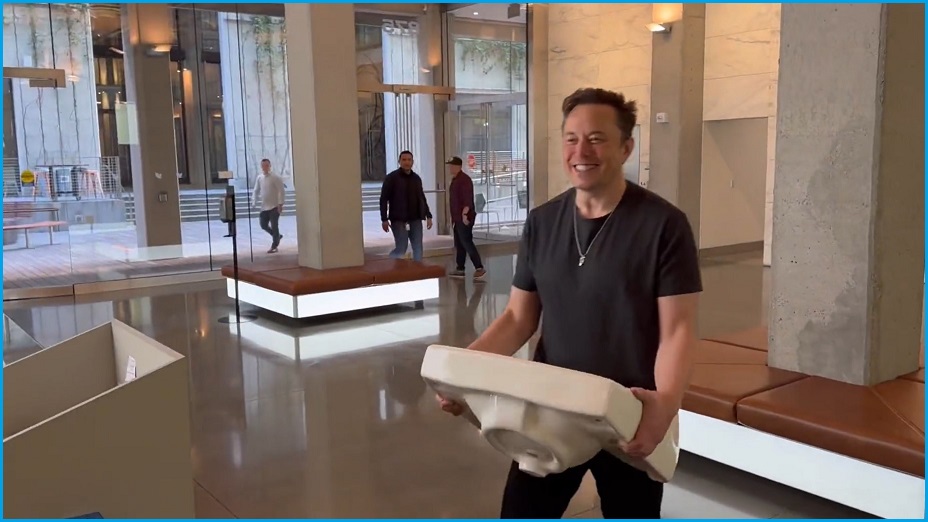Billionaire Elon Musk now officially owns Twitter after a months-long saga which saw him threaten to walk away from the US$44 billion deal.
Musk posted a video of himself walking into the social media company’s San Francisco headquarters on Thursday carrying a white sink with the caption “let that sink in”.
Now chaos reigns inside the social media platform as Musk looks to radically change Twitter by firing staff, testing the mettle of software engineers, and resurrecting old features.
From the outset, the CEO of Tesla and SpaceX threw his weight around, sacking four senior executives on his first day in the office, including CEO Parag Agrawal who took over from the social media company’s co-founder in November last year.
Following Agrawal out the door was Twitter’s CFO Ned Segal, Head of Legal Vijaya Gadde, and General Counsel Sean Edgett.
Musk reportedly fired the executives ‘for cause’ in an attempt to avoid having to pay out tens of millions of dollars as per the acquisition deal, which could land Musk and Twitter back in court.
Musk has also dissolved Twitter’s board of directors to make himself the sole director for the time being.
One of the stranger things to happen during the first tumultuous hours of the Musk era at Twitter was a directive for engineers to physically print out the last month’s worth of code they’ve written for review.
Internal Slack screenshots that were shared with journalist Casey Newton showed messages telling engineers to “Please print out 50 pages of code you’ve done in the last 30 days (if you haven’t submitted code in the past 30 days, then you can go back up to 60 days)”.
Soon after engineers scrambled to get their code on paper, they were told to “stop printing” and shred the pages of code.
It’s understood Musk was looking to weed out a layer of management that hadn’t been actively contributing to development.
He has also brought in top engineers from Tesla to have a look at the codebase and has directed another team to start looking at the code for Vine, a short-form video platform Twitter bought in 2012 and killed off four years later.
Musk wants Vine up and running by the end of the year, but one engineer told Axios “it needs a lot of work”.
Another feature Twitter’s new CEO has engineers scrambling to work on is verification – the blue tick that appears next to some accounts.
Musk reportedly wants to have verification built-in as a feature of the Twitter Blue subscription for which he’ll charge around US$20 a month and will give current verified accounts 90 days to subscribe or lose their blue tick.
The development team responsible has a deadline of 7 November to get the new verification feature up and running or they will be out of a job, according to the Verge.
Is the bird free?
Musk has previously claimed to be a ‘free speech absolutist’ and there were early suggestions that when he took over Twitter, moderation would go by the wayside.
Shortly after taking over, Musk said he would convene “a content moderation council with widely diverse viewpoints” to decide on matters of moderation – although no decisions had yet been made to change content on Twitter.
Still, certain parts of the site felt emboldened by Twitter’s new head with reports that use of a certain racial slur went up by 500 per cent in his first 12 hours, which may have been the result of a targeted 4chan campaign.
Almost as if to demonstrate the potential for misinformation to spread like wildfire if anyone with a credit card is given verification and moderation is treated with a light tough, Musk tweeted a reply to former US secretary of state Hillary Clinton about a violent attack on the husband of US House Speaker Nancy Pelosi which linked to a known source of conspiracy theories and misinformation.
“There is a tiny possibility there might be more to this story than meets the eye,” Musk said in the now-deleted tweet.
Musk has also suggested he will reverse lifetime bans of certain people, including former US President Donald Trump.
The new cavalier management and uncertainty around how content will be moderated in the future, has prompted some brands to step away from advertising on Twitter including General Motors which, notably, is also a competitor of Tesla.
In a letter to advertisers, Musk said he didn’t buy Twitter “because it would be easy” or “to make more money” but rather “to try to help humanity, whom I love”.
When Musk tweeted that “the bird is freed”, European Commissioner Thierry Breton responded saying “in Europe, the bird will fly by our rules”.










